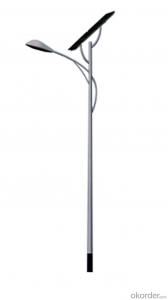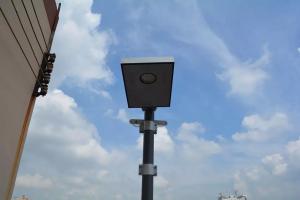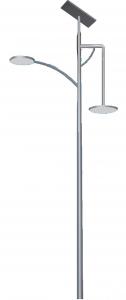Solar Light Posts for Yard - New Energy Solar Street Light T600
- Loading Port:
- Ningbo
- Payment Terms:
- TT or LC
- Min Order Qty:
- 1 set
- Supply Capability:
- 5000 set/month
OKorder Service Pledge
OKorder Financial Service
You Might Also Like
1, Product desciption
Inverter circuits designed to produce a variable output voltage range are often used within motor speed controllers.
The DC power for the inverter section can be derived from a normal AC wall outlet or some other source. Control and feedback circuitry is used to adjust the final output of the inverter section which will ultimately determine the speed of the motor operating under its mechanical load.
Motor speed control needs are numerous and include things like: industrial motor driven equipment, electric vehicles, rail transport systems, and power tools. (See related: variable-frequency drive ) Switching states are developed for positive, negative and zero voltages as per the patterns given in the switching Table.
The generated gate pulses are given to each switch in accordance with the developed pattern and thus the output is obtained.
Solar power is energy from the sun. "Solar" is the Latin word for "sun" and
And Powerful source of energy. Without it, there will be no life.
Solar energy is considered as a serious source of energy for many years
of the vast amounts of energy that is made freely available, if harnessed by modern technology.
A magnifying glass can be used to heat up a small amount of water.
The short piece of copper tube is sealed at one end and filled with water.
And magnifying glass is then used to warm up the pipe.
Using more than one magnifying glass will increase the temperature more rapidly.
2, Features of the product
Inverters convert low frequency main AC power to higher frequency for use in induction heating.
To do this, AC power is first rectified to provide DC power. The inverter then changes the DC power to high frequency AC power. Due to the reduction in the number of DC Sources employed, the structure becomes more reliable and the output voltage has higher resolution due to an increase in the number of steps so that the reference sinusoidal voltage can be better achieved.
This configuration has recently become very popular in AC power supply and adjustable speed drive applications. This new inverter can avoid extra clamping diodes or voltage balancing capacitors. There are three kinds of level shifted modulation techniques, namely:
The first thing to figure out is the length of road in need of street lights.
This can be a small entrance road only a couple hundred of feet long to miles of streets through an area. Does the area currently have any type of lighting available.
What is the reason for needing street lights in this area
Is the electrical grid already nearby or would you need to call in the power company to bring in electrical lines.
If the electric needs to be brought to the area, how much is this going to cost? Depending on how far the grid electric is from the location of the needed lighting, this can be quite expensive.
How much lighting is needed on the street? Do the lights need to be dark sky compliant.
Do the street lights need to run from dusk to dawn or for only a specified number of hours at night.
Are the street lights able to dim in the middle of the night and still provide enough lighting.
These questions need to be answered before you can decide on how many lights you will need to complete the project.
3, Detailed Specification
| ||||||||||||||||||||||||||||||||||||||||||||||||
4, Product Image

- Q: Are solar lights adjustable?
- Yes, solar lights are often adjustable. Many solar lights have adjustable settings for the brightness, motion sensitivity, and angle of the light to maximize their efficiency and meet individual preferences and needs.
- Q: What is the range of motion detection in solar lights?
- The range of motion detection in solar lights typically varies, but it is commonly around 120 degrees.
- Q: Do solar lights have a built-in sensor for detecting darkness?
- Yes, most solar lights have a built-in sensor known as a photovoltaic cell or a light sensor that detects darkness. This sensor allows the solar light to automatically turn on at dusk or when it gets dark and turn off at dawn or when it gets light again. The sensor is typically located on the top of the solar light, exposed to the surrounding environment, allowing it to sense changes in light levels. This feature not only ensures that solar lights operate efficiently and conserve energy during daylight hours but also provides convenience by eliminating the need for manual operation.
- Q: What is the average cost of solar lights?
- The price of solar lights can vary depending on several factors, including the type of solar light, its features, brand, and quality. Generally, basic solar lights like pathway lights or garden lights can range from $15 to $50 per light. These lights are small, have a lower lumen output, and are primarily used for decoration. For more advanced solar lights with features like motion sensors, adjustable brightness, or larger solar panels, the average cost can range from $50 to $150 per light. These lights are commonly used for security purposes or to provide brighter illumination for larger areas. It's important to consider that the cost of solar lights may also be affected by factors such as material quality, durability, and the reputation of the manufacturer. While higher-end solar lights from reputable brands may be more expensive, they generally offer better performance and last longer. Additionally, any additional installation or setup requirements can influence the cost of solar lights. Some solar lights may need professional installation, which can increase the overall cost. In conclusion, when determining the average cost of solar lights, it is advisable to identify your specific needs, evaluate the quality and features required, and compare prices from different manufacturers or retailers to find the best value for your investment.
- Q: Do solar lights require any permits for installation?
- In most cases, solar lights do not require any permits for installation. Since they are typically installed on existing structures or in outdoor spaces, they do not involve any major construction or electrical work. However, it's always advisable to check with local authorities or homeowners associations to ensure compliance with any specific regulations or guidelines that may apply in your area.
- Q: Can solar lights be used in high-wind areas?
- Yes, solar lights can be used in high-wind areas. However, it is important to choose solar lights specifically designed for such conditions, with sturdy construction and secure mounting options. Additionally, regular maintenance and inspection may be necessary to ensure the lights remain functioning properly in high-wind environments.
- Q: How do solar lights provide consistent brightness throughout the night?
- Solar lights provide consistent brightness throughout the night by storing the energy they absorb from the sun during the day in a rechargeable battery. This battery powers the light source, usually an LED, during the night, ensuring a steady and reliable illumination until the stored energy is depleted.
- Q: Are solar lights suitable for use in coastal areas?
- Yes, solar lights are suitable for use in coastal areas. In fact, they can be an excellent option for illuminating outdoor spaces in coastal regions. Solar lights are designed to harness solar energy, converting it into electricity and storing it in rechargeable batteries. This means that they do not require a direct electrical connection and can be installed in remote areas. Coastal areas often have abundant sunlight throughout the year, making them ideal for solar lights. These lights use photovoltaic cells to absorb sunlight during the day and convert it into electricity to power the light at night. The ample sunshine in coastal regions ensures that the solar panels can generate enough energy to keep the lights illuminated even during cloudy days or in areas with limited sunlight. Another advantage of solar lights in coastal areas is their durability. Many solar lights are designed to withstand the harsh coastal environment, including exposure to saltwater, humidity, and strong winds. They are often made with corrosion-resistant materials, such as stainless steel or high-quality plastics, to prevent rust and damage from saltwater. Furthermore, solar lights are environmentally friendly and energy-efficient. By using renewable energy, they reduce the carbon footprint and reliance on traditional electricity sources. In coastal areas, where the preservation of natural resources is crucial, solar lights provide a sustainable lighting solution. However, it is important to note that certain considerations should be taken into account when choosing solar lights for coastal areas. It is recommended to select lights specifically designed for coastal environments to ensure they can withstand the harsh conditions. Additionally, regular maintenance, such as cleaning the solar panels to remove salt deposits, may be necessary to ensure optimal performance. Overall, solar lights are a suitable and practical lighting option for coastal areas. They offer a sustainable, energy-efficient, and durable solution for illuminating outdoor spaces while minimizing the impact on the environment.
- Q: Are solar lights suitable for parking lots and streets?
- Absolutely! Parking lots and streets can definitely benefit from the use of solar lights. These lights are not only suitable, but they also offer a cost-effective and sustainable lighting option for outdoor spaces. As they are powered by solar energy, there is no need for electricity from the grid and they do not contribute to greenhouse gas emissions. Installing and maintaining solar lights is a breeze, making them a practical choice for parking lots and streets. They have a long-lasting lifespan and can provide reliable lighting throughout the night. What's more, solar lights come equipped with advanced technology that automatically adjusts their brightness based on the surroundings, ensuring optimal visibility for both drivers and pedestrians. All in all, solar lights present a viable and eco-friendly solution for illuminating parking lots and streets.
- Q: Can solar lights be used for bicycle lighting?
- Yes, solar lights can be used for bicycle lighting. They are a sustainable and energy-efficient option that can provide illumination for cycling at night.
Send your message to us
Solar Light Posts for Yard - New Energy Solar Street Light T600
- Loading Port:
- Ningbo
- Payment Terms:
- TT or LC
- Min Order Qty:
- 1 set
- Supply Capability:
- 5000 set/month
OKorder Service Pledge
OKorder Financial Service
Similar products
Hot products
Hot Searches
Related keywords



























